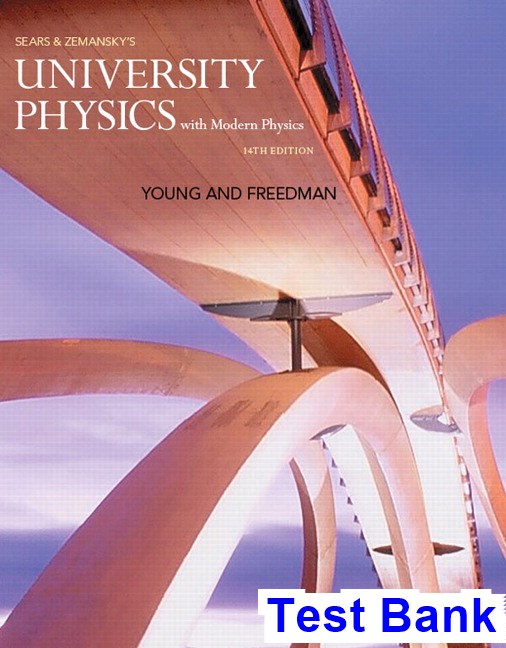This is completed downloadable of University Physics with Modern Physics 14th Edition Young Test Bank

Product Details:
- ISBN-10 : 0133969290
- ISBN-13 : 978-0133969290
- Author:
Since its first edition, University Physics has been revered for its emphasis on fundamental principles and how to apply them. This text is known for its clear and thorough narrative, as well as its uniquely broad, deep, and thoughtful sets of worked examples that provide students with key tools for developing both conceptual understanding and problem-solving skills.
The Fourteenth Edition improves the defining features of the text while adding new features influenced by education research to teach the skills needed by today’s students. A focus on visual learning, new problem types, and pedagogy informed by MasteringPhysics metadata headline the improvements designed to create the best learning resource for physics students.
Table of Content:
- 1. Units, Physical Quantities,and Vectors
- 1.1. The Nature of Physics
- 1.2. Solving Physics Problems
- 1.3. Standards and Units
- 1.4. Using and Converting Units
- 1.5. Uncertainty and Significant Figures
- 1.6. Estimates and Orders of Magnitude
- 1.7. Vectors and Vector Addition
- 1.8. Components of Vectors
- 1.9. Unit Vectors
- 1.10. Products of Vectors
- Chapter 1 Summary
- Problems
- 2. Motion Along a Straight Line
- 2.1. Displacement, Time, and Average Velocity
- 2.2. Instantaneous Velocity
- 2.3. Average and Instantaneous Acceleration
- 2.4. Motion with Constant Acceleration
- 2.5. Freely Falling Bodies
- 2.6. Velocity and Position by Integration
- Chapter 2 Summary
- Problems
- 3. Motion in Two or Three Dimensions
- 3.1. Position and Velocity Vectors
- 3.2. The Acceleration Vector
- 3.3. Projectile Motion
- 3.4. Motion in a Circle
- 3.5. Relative Velocity
- Chapter 3 Summary
- Problems
- 4. Newton’s Laws of Motion
- 4.1. Force and Interactions
- 4.2. Newton’s First Law
- 4.3. Newton’s Second Law
- 4.4. Mass and Weight
- 4.5. Newton’s Third Law
- 4.6. Free-Body Diagrams
- Chapter 4 Summary
- Problems
- 5. Applying Newton’s Laws
- 5.1. Using Newton’s First Law: Particles in Equilibrium
- 5.2. Using Newton’s Second Law: Dynamics of Particles
- 5.3. Friction Forces
- 5.4. Dynamics of Circular Motion
- 5.5. The Fundamental Forces of Nature
- Chapter 5 Summary
- Problems
- 6. Work and Kinetic Energy
- 6.1. Work
- 6.2. Kinetic Energy and the Work–Energy Theorem
- 6.3. Work and Energy with Varying Forces
- 6.4. Power
- Chapter 6 Summary
- Problems
- 7. Potential Energy and Energy Conservation
- 7.1. Gravitational Potential Energy
- 7.2. Elastic Potential Energy
- 7.3. Conservative and Nonconservative Forces
- 7.4. Force and Potential Energy
- 7.5. Energy Diagrams
- Chapter 7 Summary
- Problems
- 8. Momentum, Impulse, and Collisions
- 8.1. Momentum and Impulse
- 8.2. Conservation of Momentum
- 8.3. Momentum Conservation and Collisions
- 8.4. Elastic Collisions
- 8.5. Center of Mass
- 8.6. Rocket Propulsion
- Chapter 8 Summary
- Problems
- 9. Rotation of Rigid Bodies
- 9.1. Angular Velocity and Acceleration
- 9.2. Rotation with Constant Angular Acceleration
- 9.3. Relating Linear and Angular Kinematics
- 9.4. Energy in Rotational Motion
- 9.5. Parallel-Axis Theorem
- 9.6. Moment-of-Inertia Calculations
- Chapter 9 Summary
- Problems
- 10. Dynamics of Rotational Motion
- 10.1. Torque
- 10.2. Torque and Angular Acceleration for a Rigid Body
- 10.3. Rigid-Body Rotation About a Moving Axis
- 10.4. Work and Power in Rotational Motion
- 10.5. Angular Momentum
- 10.6. Conservation of Angular Momentum
- 10.7. Gyroscopes and Precession
- Chapter 10 Summary
- Problems
- 11. Equilibrium and Elasticity
- 11.1. Conditions for Equilibrium
- 11.2. Center of Gravity
- 11.3. Solving Rigid-Body Equilibrium Problems
- 11.4. Stress, Strain, and Elastic Moduli
- 11.5. Elasticity and Plasticity
- Chapter 11 Summary
- Problems
- 12. Fluid Mechanics
- 12.1. Gases, Liquids, and Density
- 12.2. Pressure in a Fluid
- 12.3. Buoyancy
- 12.4. Fluid Flow
- 12.5. Bernoulli’s Equation
- 12.6. Viscosity and Turbulence
- Chapter 12 Summary
- Problems
- 13. Gravitation
- 13.1. Newton’s Law of Gravitation
- 13.2. Weight
- 13.3. Gravitational Potential Energy
- 13.4. The Motion of Satellites
- 13.5. Kepler’s Laws and the Motion of Planets
- 13.6. Spherical Mass Distributions
- 13.7. Apparent Weight and the Earth’s Rotation
- 13.8. Black Holes
- Chapter 13 Summary
- Problems
- 14. Periodic Motion
- 14.1. Describing Oscillation
- 14.2. Simple Harmonic Motion
- 14.3. Energy in Simple Harmonic Motion
- 14.4. Applications of Simple Harmonic Motion
- 14.5. The Simple Pendulum
- 14.6. The Physical Pendulum
- 14.7. Damped Oscillations
- 14.8. Forced Oscillations and Resonance
- Chapter 14 Summary
- Problems
- 15. Mechanical Waves
- 15.1. Types of Mechanical Waves
- 15.2. Periodic Waves
- 15.3. Mathematical Description of a Wave
- 15.4. Speed of a Transverse Wave
- 15.5. Energy in Wave Motion
- 15.6. Wave Interference, Boundary Conditions, and Superposition
- 15.7. Standing Waves on a String
- 15.8. Normal Modes of a String
- Chapter 15 Summary
- Problems
- 16. Sound and Hearing
- 16.1. Sound Waves
- 16.2. Speed of Sound Waves
- 16.3. Sound Intensity
- 16.4. Standing Sound Waves and Normal Modes
- 16.5. Resonance and Sound
- 16.6. Interference of Waves
- 16.7. Beats
- 16.8. The Doppler Effect
- 16.9. Shock Waves
- Chapter 16 Summary
- Problems
- 17. Temperature and Heat
- 17.1. Temperature and Thermal Equilibrium
- 17.2. Thermometers and Temperature Scales
- 17.3. Gas Thermometers and the Kelvin Scale
- 17.4. Thermal Expansion
- 17.5. Quantity of Heat
- 17.6. Calorimetry and Phase Changes
- 17.7. Mechanisms of Heat Transfer
- Chapter 17 Summary
- Problems
- 18. Thermal Properties of Matter
- 18.1. Equations of State
- 18.2. Molecular Properties of Matter
- 18.3. Kinetic-Molecular Model of an Ideal Gas
- 18.4. Heat Capacities
- 18.5. Molecular Speeds
- 18.6. Phases of Matter
- Chapter 18 Summary
- Problems
- 19. The First Law of Thermodynamics
- 19.1. Thermodynamic Systems
- 19.2. Work Done During Volume Changes
- 19.3. Paths between Thermodynamic States
- 19.4. Internal Energy and the First Law of Thermodynamics
- 19.5. Kinds of Thermodynamic Processes
- 19.6. Internal Energy of an Ideal Gas
- 19.7. Heat Capacities of an Ideal Gas
- 19.8. Adiabatic Processes for an Ideal Gas
- Chapter 19 Summary
- Problems
- 20. The Second Law of Thermodynamics
- 20.1. Directions of Thermodynamic Processes
- 20.2. Heat Engines
- 20.3. Internal-Combustion Engines
- 20.4. Refrigerators
- 20.5. The Second Law of Thermodynamics
- 20.6. The Carnot Cycle
- 20.7. Entropy
- 20.8. Microscopic Interpretation of Entropy
- Chapter 20 Summary
- Problems
- 21. Electric Charge and Electric Field
- 21.1. Electric Charge
- 21.2. Conductors, Insulators, and Induced Charges
- 21.3. Coulomb’s Law
- 21.4. Electric Field and Electric Forces
- 21.5. Electric-Field Calculations
- 21.6. Electric Field Lines
- 21.7. Electric Dipoles
- Chapter 21 Summary
- Problems
- 22. Gauss’s Law
- 22.1. Charge and Electric Flux
- 22.2. Calculating Electric Flux
- 22.3. Gauss’s Law
- 22.4. Applications of Gauss’s Law
- 22.5. Charges on Conductors
- Chapter 22 Summary
- Problems
- 23. Electric Potential
- 23.1. Electric Potential Energy
- 23.2. Electric Potential
- 23.3. Calculating Electric Potential
- 23.4. Equipotential Surfaces
- 23.5. Potential Gradient
- Chapter 23 Summary
- Problems
- 24. Capacitance and Dielectrics
- 24.1. Capacitors and Capacitance
- 24.2. Capacitors in Series and Parallel
- 24.3. Energy Storage in Capacitors and Electric-Field Energy
- 24.4. Dielectrics
- 24.5. Molecular Model of Induced Charge
- 24.6. Gauss’s Law in Dielectrics
- Chapter 24 Summary
- Problems
- 25. Current, Resistance, and Electromotive Force
- 25.1. Current
- 25.2. Resistivity
- 25.3. Resistance
- 25.4. Electromotive Force and Circuits
- 25.5. Energy and Power in Electric Circuits
- 25.6. Theory of Metallic Conduction
- Chapter 25 Summary
- Problems
- 26. Direct-Current Circuits
- 26.1. Resistors in Series and Parallel
- 26.2. Kirchhoff’s Rules
- 26.3. Electrical Measuring Instruments
- 26.4. R-C Circuits
- 26.5. Power Distribution Systems
- Chapter 26 Summary
- Problems
- 27. Magnetic Field and Magnetic Forces
- 27.1. Magnetism
- 27.2. Magnetic Field
- 27.3. Magnetic Field Lines and Magnetic Flux
- 27.4. Motion of Charged Particles in a Magnetic Field
- 27.5. Applications of Motion of Charged Particles
- 27.6. Magnetic Force on a Current-Carrying Conductor
- 27.7. Force and Torque on a Current Loop
- 27.8. The Direct-Current Motor
- 27.9. The Hall Effect
- Chapter 27 Summary
- Problems
- 28. Sources of Magnetic Field
- 28.1. Magnetic Field of a Moving Charge
- 28.2. Magnetic Field of a Current Element
- 28.3. Magnetic Field of a Straight Current-Carrying Conductor
- 28.4. Force Between Parallel Conductors
- 28.5. Magnetic Field of a Circular Current Loop
- 28.6. Ampere’s Law
- 28.7. Applications of Ampere’s Law
- 28.8. Magnetic Materials
- Chapter 28 Summary
- Problems
- 29. Electromagnetic Induction
- 29.1. Induction Experiments
- 29.2. Faraday’s Law
- 29.3. Lenz’s Law
- 29.4. Motional Electromotive Force
- 29.5. Induced Electric Fields
- 29.6. Eddy Currents
- 29.7. Displacement Current and Maxwell ’s Equations
- 29.8. Superconductivity
- Chapter 29 Summary
- Problems
- 30. Inductance
- 30.1. Mutual Inductance
- 30.2. Self-Inductance and Inductors
- 30.3. Magnetic-Field Energy
- 30.4. The R-L Circuit
- 30.5 The L-C Circuit
- 30.6. The L-R-C Series Circuit
- Chapter 30 Summary
- Problems
- 31. Alternating Current
- 31.1. Phasors and Alternating Currents
- 31.2. Resistance and Reactance
- 31.3. The L-R-C Series Circuit
- 31.4. Power in Alternating-Current Circuits
- 31.5. Resonance in Alternating-Current Circuits
- 31.6. Transformers
- Chapter 31 Summary
- Problems
- 32. Electromagnetic Waves
- 32.1. Maxwell ’s Equations and Electromagnetic Waves
- 32.2. Plane Electromagnetic Waves and the Speed of Light
- 32.3. Sinusoidal Electromagnetic Waves
- 32.4. Energy and Momentum in Electromagnetic Waves
- 32.5. Standing Electromagnetic Waves
- Chapter 32 Summary
- Problems
- 33. The Nature and Propagation of Light
- 33.1. The Nature of Light
- 33.2. Reflection and Refraction
- 33.3. Total Internal Reflection
- 33.4. Dispersion
- 33.5. Polarization
- 33.6. Scattering of Light
- 33.7. Huygens’s Principle
- Chapter 33 Summary
- Problems
- 34. Geometric Optics
- 34.1. Reflection and Refraction at a Plane Surface
- 34.2. Reflection at a Spherical Surface
- 34.3. Refraction at a Spherical Surface
- 34.4. Thin Lenses
- 34.5. Cameras
- 34.6. The Eye
- 34.7. The Magnifier
- 34.8. Microscopes and Telescopes
- Chapter 34 Summary
- Problems
- 35. Interference
- 35.1. Interference and Coherent Sources
- 35.2. Two-Source Interference of Light
- 35.3. Intensity in Interference Patterns
- 35.4. Interference in Thin Films
- 35.5. The Michels on Interferometer
- Chapter 35 Summary
- Problems
- 36. Diffraction
- 36.1. Fresnel and Fraunhofer Diffraction
- 36.2. Diffraction from a Single Slit
- 36.3. Intensity in the Single-Slit Pattern
- 36.4. Multiple Slits
- 36.5. The Diffraction Grating
- 36.6. X-Ray Diffraction
- 36.7. Circular Apertures and Resolving Power
- 36.8. Holography
- Chapter 36 Summary
- Problems
- 37. Relativity
- 37.1. Invariance of Physical Laws
- 37.2. Relativity of Simultaneity
- 37.3. Relativity of Time Intervals
- 37.4. Relativity of Length
- 37.5. The Lorentz Transformations
- 37.6. The Doppler Effect for Electromagnetic Waves
- 37.7. Relativistic Momentum
- 37.8. Relativistic Work and Energy
- 37.9. Newtonian Mechanics and Relativity
- Chapter 37 Summary
- Problems
- 38. Photons: Light Waves Behaving as Particles
- 38.1. Light Absorbed as Photons: The Photoelectric Effect
- 38.2. Light Emitted as Photons: X-Ray Production
- 38.3. Light Scattered as Photons: Compton Scattering and Pair Production
- 38.4. Wave–Particle Duality, Probability, and Uncertainty
- Chapter 38 Summary
- Problems
- 39. Particles Behaving as Waves
- 39.1. Electron Waves
- 39.2. The Nuclear Atom and Atomic Spectra
- 39.3. Energy Levels and the Bohr Model of the Atom
- 39.4. The Laser
- 39.5. Continuous Spectra
- 39.6. The Uncertainty Principle Revisited
- Chapter 39 Summary
- Problems
- 40. Quantum Mechanics I: Wave Functions
- 40.1. Wave Functions and the One-Dimensional Schrödinger Equation
- 40.2. Particle in a Box
- 40.3. Potential Wells
- 40.4. Potential Barriers and Tunneling
- 40.5. The Harmonic Oscillator
- 40.6. Measurement in Quantum Mechanics
- Chapter 40 Summary
- Problems
- 41. Quantum Mechanics II : Atomic Structure
- 41.1. The Schrödinger Equationin Three Dimensions
- 41.2. Particle in a Three-Dimensional Box
- 41.3. The Hydrogen Atom
- 41.4. The Zeeman Effect
- 41.5. Electron Spin
- 41.6. Many-Electron Atoms and the Exclusion Principle
- 41.7. X-Ray Spectra
- 41.8. Quantum Entanglement
- Chapter 41 Summary
- Problems
- 42. Molecules and Condensed Matter
- 42.1. Types of Molecular Bonds
- 42.2. Molecular Spectra
- 42.3. Structure of Solids
- 42.4. Energy Bands
- 42.5. Free-Electron Model of Metals
- 42.6. Semiconductors
- 42.7. Semiconductor Devices
- 42.8. Superconductivity
- Chapter 42 Summary
- Problems
- 43. Nuclear Physics
- 43.1. Properties of Nuclei
- 43.2. Nuclear Binding and Nuclear Structure
- 43.3. Nuclear Stability and Radioactivity
- 43.4. Activities and Half-Lives
- 43.5. Biological Effects of Radiation
- 43.6. Nuclear Reactions
- 43.7. Nuclear Fission
- 43.8. Nuclear Fusion
- Chapter 43 Summary
- Problems
- 44. Particle Physics and Cosmology
- 44.1. Fundamental Particles—A History
- 44.2. Particle Accelerators and Detectors
- 44.3. Particles and Interactions
- 44.4. Quarks and Gluons
- 44.5. The Standard Model and Beyond
- 44.6. The Expanding Universe
- 44.7. The Beginning of Time
- Chapter 44 Summary
- Problems
- Appendix A: The International System of Units
- Appendix B: Useful Mathematical Relations
- Appendix C: The Greek Alphabet
- Appendix D: Periodic Table of the Elements
- Appendix E: Unit Conversion Factors
- Appendix F: Numerical Constants
- Answers to Odd-Numbered Problems
- Credits
- Index
- Back Cover





